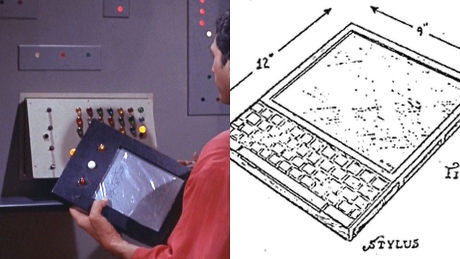Tablets: Past, Present and Future Part I

(Jason Perlow) To mix up the menu, Tech Broiler will be introducing new blogger voices with select feature posts. For our inaugural installment of Tech Broiler Voices, it is my pleasure to introduce Scott Raymond, an avid PC and technology enthusiast who's done quite a bit of legwork on all the iPad alternatives coming out from major OEMs. Here is Scott's first installment in a two-part series about the Tablet's Past, Present and Future. For the second part, click here.

The beginnings of the Tablet computer: Star Trek's PADD (Left) and Alan Kay's Dynabook (Right)
The Tablet's Past:
The beginnings of the tablet computing device can be traced back to the original PADD devices in the original Star Trek TV series that debuted in 1966: wedge-shaped black clipboard style devices with a couple of lights glued to it. The “screen” on the PADD -- a term that would not be coined until the series revival 20 years later --- was actually taken from a magic slate toy, the kind where you peel up the plastic sheet to erase it.A more sophisticated Tablet Computer made an appearance in Stanley Kubrick's and Arthur C. Clarke's futurist and prescient Sci-Fi film 2001: A Space Odyssey (1968). Kubrick envisioned a portable screen that the astronauts on the Jupiter space ship Discovery could use for entertainment purposes and work to interface with HAL, the ship's main computer. This portable screen, shown below in a scene from the film displaying a BBC interview with astronaut Frank Poole, was one of the first realistic early depictions of Tablets as we recognize them today.
Tablet Computer as seen in 2001: A Space Odyssey (1968)
Tablets may have been born out of Science Fiction but it didn't take long for them to move into the realm of Science Fact.
In the late 1960s and early 1970s, Alan Kay -- then working at Xerox Palo Alto Research Laboratories (PARC) envisioned the Dynabook personal computing device: a tablet with similar dimensions to that of the iPad, with a keyboard, stylus and multitouch screen. The current devices aren't $100 as Alan Kay envisioned in his early papers on the proposed device, but when adjusted for 40 years of inflation that may actually have been a fairly close estimate -- approximately $500.00.
The sudden demand for tablet devices is not a paradigm shift, but rather a success after many years of failure. In fact, attempts to bring tablet or handheld devices to the masses have occurred several times in the past with varying levels of success and failure.
These early attempts include the Apple Newton, the Palm Pilot, Windows CE/Pocket PC devices, even the Microsoft Origami project, known as UMPC (Ultra-Mobile PCs). Some faded into obscurity, others led to the dawn of the smartphone era. None of them were universally accepted as the new standard of mobile computing.
The Apple iPad comes at an opportune time. Smartphones with capabilities that come very close to replacing the need for a laptop while on the move have enabled their users to be more productive (or less, depending on the usage) and have encouraged their users to want more capabilities.
With some exceptions in terms of features that Apple's customers may feel are lacking, the iPad has set the bar in terms of what people expect out of a tablet device. However you might feel about Apple, they brought out the iPad at exactly the right time and took the lead on tablet devices. Every other company that wants to compete in the market will need to be as good or better than Apple in order to be successful.
For the iPad, Apple used their iPhone/iPod Touch OS. The iPad is at its core a giant iPod Touch. The primary difference is that has a faster processor, more memory (in the upper end models) and a large, 9.7" sharp In-Plane-Switching (IPS) LCD display.
By keeping the architecture primarily the same, Apple was able to leverage the existing iPhone OS instead of starting from scratch or trying to cram Mac OS X into an underpowered chassis. To have attempted it would have been to duplicate the disastrous Microsoft UMPC devices – tiny screens, slow, underpowered, poor battery life and difficult to use. You can still find these devices for sale online, but they are more useful as a conversation piece than as a usable laptop replacement.
Some folks might ask, "Why we don't just use Tablet PCs?" Many people do. However, the tablet-based laptop is a full laptop computer with a screen that can turn around and fold flat. They are typically rugged, useful devices. But unlike the iPad, which weighs 1.5lbs, they are fairly heavy. Most of the 12” tablet PCs weigh in at 5 lbs or more.
On Tablet PCs, battery life varies greatly, but tends to be much less than that of the iPad. Larger batteries that provide more battery life add substantial bulk and weight. There are several tablet netbooks that have great battery life and are lightweight, but they use the Intel Atom CPU which has proven to be pokey and slow under heavy load due to being a single-core processor that doesn't excel at multitasking.
Admittedly, the iPad doesn't do multitasking either, but it wasn't really designed to. Apple's iPhone OS 4.0 will finally introduce multitasking, so it won't be long before the iPad has it as well. This functionality improvement in the iPad and OS upgrade is expected to arise in the Fall of 2010 after the new iPhone 4G models have been released.
The sweet spot for tablet-based devices seems to be where the iPad resides, with some additions. A device the size of a piece of letter paper (8.5 x 11 inches), less than 2 lbs, 8-10 hours of battery life, a front-facing camera, wifi and 3G network connectivity, SD card memory expansion, Bluetooth, and a USB port to connect external devices. The price of such a unit should fall between $400-$700 USD.
While there are devices of many shapes and sizes, I am going to try to focus on ones that fit these particular specifications.
The Tablet's Present:
I will not rehash existing information about the iPad; there is already a wealth of information available on that subject. You can't avoid reading about it at this point. Also, we will not be presenting any off-brand devices. While it's true that there are actually quite a few tablet devices coming out, quality varies widely and devices like this appear on the market quickly and disappear just as quickly. Warranty coverage tends to be spotty at best. It's a good idea to stick with a reputable international company that has good warranty coverage.MSI Tegra 2-based Android Tablet
At CES this year, MSI introduced their Tegra 2-based Android tablet device. The NVIDIA dual core ARM processor is a great choice for tablet-based devices. It is compatible with Android, Windows CE, Windows Mobile and the upcoming Chrome OS, uses less power than the Intel Atom and the Qualcomm Snapdragon processor, and has hardware acceleration for flash and HD video streaming.
MSI has not made the specifications public; at this point they are simply saying that they're being flexible in terms of what their customers want before finalizing the product for release. The Tegra 2 processor will likely be 1GHz, and the device does have at least one USB port, a front-facing camera, and an SD Card memory slot. Estimated retail price will be $500.00 USD.
If you think that's cool, however, check out what MSI is working on for the future: A dual-screen folding tablet that runs Windows 7.
Asus Eee Pad
Like MSI, Asus is also currently working on a Tegra 2-based tablet, which they reported at CES. This tablet will have 3G connectivity, and run “Microsoft Software” according to Asus CEO Jerry Shen. Interestingly, He did not specify which derivative of the Windows OS would be running on it -- presumably, it will be a variant of the new Windows Phone 7 OS. The launch announcement for the Eee Pad will be at Computex in Taiwan in June.
Dell Looking Glass
The Dell Looking Glass tablet is due to be released in November. Slightly smaller than other tablets with a 7-inch display, this Tegra 2-based device runs Android 2.1, has 4GB of RAM and a SDHC card slot that can handle memory cards of up to 32GB. It has a webcam, bluetooth and wifi connectivity, with 3G and TV tuner optional.
In addition to the Looking Glass, various designs for future Dell tablets have leaked, including 10-inch versions. No details or release dates on these new designs have yet been released.
Neofonie WePad
A German company, Neofonie has developed the WeTab (originally WePad, but there was likely a trademark dispute with Apple). Instead of an ARM-based processor, this device uses the Intel Atom N450 1.66GHz processor. While it is not a dual core CPU, it is hyperthreaded, which improves its multitasking capabilities over the previous generation of Atom processors.
The WeTab sports a large 11.6” 1366x768 display, 1GB of RAM, up to 32GB of storage via SDHC card. It has 2 USB ports, a memory card reader and a SIM card slot for 3G connectivity. It runs the Android OS and has access to the Android app store as well as the WeTab app store.
Lenovo IdeaPad U1 Hybrid
The Lenovo IdeaPad U1 hybrid is a bit of an odd duck. At first it appears to be a typical tablet laptop, with a full keyboard, running Windows 7. But instead of the screen swiveling around and folding flat, it instead disconnects from the laptop base and within seconds becomes an entirely different beast: A 1GHz Qualcomm Snapdragon processor powers a tablet running the linux-based Lenovo Skylight UI similar to that running on the Lenovo Skylight netbook.
Netbook Navigator 9
The Netbook Navigator 9 is effectively a keyboard-less netbook powered by an Intel Atom N270 1.6GHz processor and an Intel GMA950 Video Card. It comes with 1GB of RAM standard, expendable to 2GB. Storage is on solid state hard drive with a capacity of up to 128GB. Network connectivity is provided by Ethernet, Wi-Fi, 3G and Bluetooth. The NN9 also has 3 USB ports, a webcam, an SD card slot and a port replicator with VGA and ethernet ports.
Unfortunately, even though this device does run Windows 7, the Atom processor is woefully underpowered. And in order to keep the device under 2 lbs, a small 3-cell battery was used resulting in very low battery life. This is is highly undesirable as the idea of a tablet is to have a device that will allow you to untether from the power cord and not have to charge it every 2 hours.
In our next installment, we'll talk about other Tablet devices that are in the works and how you as a buyer should consider your purchasing options at this early stage in the ultralight tablet market.
Do any of these alternative Tablets whet your appetite? Talk Back and Let Us Know.